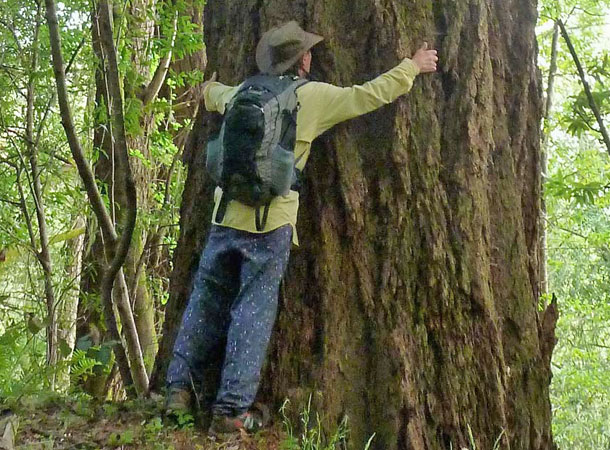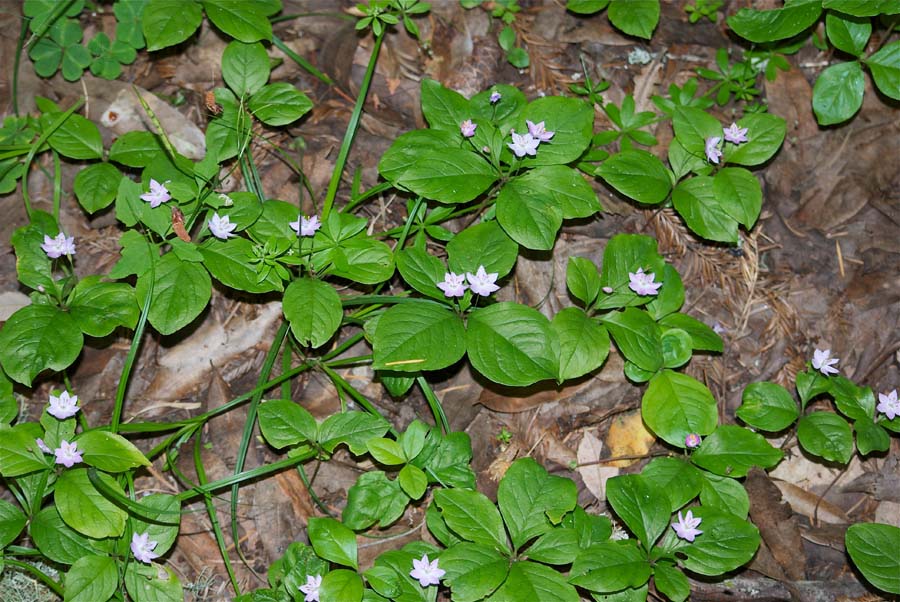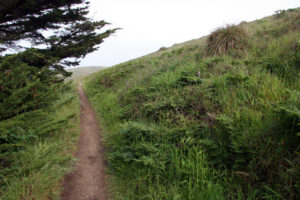May 12, 2012. Fir Top loop via Greenpicker and Bolema trails (8.0 mile loop)
Check out this and other hikes Jules has taken on this Google map. The most recent hike is in blue; others are in red.
Trail notes: The first two miles from Five Brooks Trailhead along the Greenpicker Trail to Fir Top is a mildly arduous 2-mile uphill climb on a fairly well-maintained trail. The route we took from Fir Top to intersect the Ridge Trail is easy to moderate, though trail has some difficult muddy sections pocked by horses hooves. The Ridge Trail to Bolema is easy and well maintained. Bolema to Olema Valley Trail (0.8 mi) is a fairly gradual downhill descent, but maybe challenging to weak knees. The final stretch along the Olema valley Trail (1.2 miles) is easy, though muddy in the wet season.
Weather: Perfect; warm (70-80°F), cloudless, absolutely calm.
I try to time these walks to coincide with interesting seasonal events particular to the habitat. The conifer forests of Inverness Ridge support some of the least common wood warblers on the peninsula, so this walk was forestalled until mid-May when these birds have returned from their wintering grounds in the neotropics. By now they should be singing on territory, and therefore possible to find.
The first several miles ascends the east-facing slope of Inverness Ridge through well-shaded mixed-evergreen forest. Although uphill for nearly three miles, the switchbacks avoid most steep sections. Douglas-fir is the dominant tree, and some are huge, twelve feet or more in circumference.
As the Stewart Trail begins its climb, it passes a damp escarpment on the left side of the trail that supports a fern grotto of several species and a healthy stand of western azalia (Rhododendron occidentale). Wilson’s warbler, Swainson’s thrush and pacific-slope flycatcher are the common songbirds; their serenades accompany us up the trail. Pacific wrens also chime in almost continually.
Fir Top (1324′) is the third highest elevation on the peninsula after Mount Wittenberg (1407′) and Point Reyes Hill (1336′). Trees obscure the view to the coast and the fir forest here has a mountain vibe. In fact, its one of the few places on the peninsula where two montane bird species breed–hermit warbler and Audubon’s warbler, both of which we heard when we settled down for a mid-morning snack in a sun-splashed field atop Fir Top. The hermit warbler’s breeding distribution is limited to the conifer forests of California, Oregon, and Washington state. Point Reyes is near the southern limit of its coastal breeding distribution. But it winters in mountainous regions of Central America from Mexico to Nicaragua above 2,000 feet. Hermits spends most of their time in the higher canopy of conifer forests, so they are more often heard than seen. Like several other tree top dwellers–such as Townsend’s and black-throated gray warbler–it sings a sibilant song that has evolved to travel long distances through and above the tree tops.
-
Hermit warbler (Setophaga occidentalis), adult male. Creative commons photo by Frode Jacobsen.
This song, a declaration of the warbler’s territory, accompanied us at seemingly regular intervals for the mile and a half that the Ridge Trail traces the spine of the peninsula from Fir Top to the Bolema Trail.
With his florid Victorian voice, birdman Leon Dawson (1873-1928) gives a sense of this song: “there is Hermit hidden aloft in the shapeless greenery of the under-dawn: his note is sweetest, gladdest, most seraphic of them all, lilly, lilly, lilly, lei~oleet. It is almost sacrilege to give it form: besides it is so hopeless. The preparatory notes are like the tinkle of crystal bells, and when our attention is focused, lo! the wonder happens, the exquisite lilt of the closing phrase, le~oleet.” Hear here.
Surely this forest pixie, with its dazzling plumage and transcendent song, is one of the peninsula’s sweetest secrets . . . As we get ready to leave Fir Top, we hear the familiar chortles of purple martins as they fly overhead.
The Bolema Trail connects the ridge to the Olema Valley Tail, a fairly gentle one mile descent. The conifer forest transitions into mixed evergreen, with a shrubby and tangled understory. The trail’s edge is trimmed with a profusion of pink-violet starflowers.
About half way down is a rather extensive stand of straight tall pines with long needles and large, closed-cones. Although superficially similar to our native bishop pines (Pinus muricata), these are non-native Monterey pines (Pinus radiata), planted by the Sweet Lumber Company that operated out of Five Brooks during the 1950s, before the designation of Point Reyes as a National Park. More than 50 years old, they are reaching the end of their natural life.
Crossing the trail we notice a dark blue millipede with yellow highlights.

-
This almond-scented millipede (Harpaphe haydeniana), is not an insect, but belongs to a subphylum of the arthropods, the Myriapods, which are some of the oldest animals to live on dry land, since perhaps 400 million years old. Photograph by Jules Evens.
This millipede’s warning coloration is a defense mechanism, a strategy also used by monarchs butterflies, bumblebees, and coral snakes, among others. As a teaching tool to would be predators these millipedes secrete foul-tasting and toxic prussic acid (hydrogen cyanide) when threatened.
Watching this creature’s slow progress across the path, Terry wonders, “Why do millepeds have so many legs?”
Five Brooks Pond at mid-day was alive with a flight of odontates–dragonflies and damselflies. The small damselflies are particularly difficult to identify, but there were numerous thin electric blue ones hovering and brief landing on the ferns and blackberries.

-
Male northern or boreal bluet (Enallagma spp.), waif thin and only about an inch and a half long, on sword fern leaf. Photograph by Jules Evens.

-
California or blue-eyed darmers (Ischnura spp.) in tandem, a mating wheel. The female, below, will bend her abdomen upwards to receive sperm from the male. Photograph by Jules Evens.
So, on this hike we found our quarry, some breeding wood warblers that are only in evidence during the singing season. But as is often the case, there were also some unexpected enchantments–starflowers, flights of bluets, wheels of darners–and the calm equanimity that comes from a full day in the field with an old friend.
Critter List
Invertebrates
California or Blue-eyed Darner
Lorquin’s Admiral
Margined White Butterfly
Millipede
Northern or Boreal Bluet
Pale Swallow-tailed Butterfly
Satyr Anglewing
Herps
Pacific Chorus Frog
Pacific Pond Turtle
Birds
Acorn Woodpecker
Allen’s Hummingbird
American Goldfinch
American Robin
Anna’s Hummingbird
Band-tailed Pigeon
Bewick’s Wren
Black Phoebe
Black-headed Grosbeak
Black-throated Gray Warbler
Brewer’s Blackbird
Brown Creeper
Bushtit
California Quail
California Towhee
Chestnut-backed Chickadee
Common Raven
Dark-eyed Junco
Double-crested Cormorant
Golden-crowned Kinglet
Great Blue Heron
Hairy Woodpecker
Hermit Thrush
Hermit Warbler
Hutton’s Vireo
MacGillivray’s Warbler
Northern Flicker
Orange-crowned Warbler
Osprey
Pacific-slope Flycatcher
Pileated Woodpecker
Purple Finch
Purple Martin
Pygmy Nuthatch
Red-breasted Nuthatch
Song Sparrow
Spotted Towhee
Steller’s Jay
Swainson’s Thrush
Townsend’s Warbler
Tree Swallow
Turkey Vulture
Varied Thrush
Violet-green Swallow
Warbling Vireo
Western Scrub-Jay
Western Wood-Pewee
Wilson’s Warbler
Winter Wren
Wrentit
Yellow-rumped (Audubon’s) Warbler
Mammals
Bobcat (scat)
Western Gray Squirrel
Acknowledgements: Thanks to Terry Nordbye for his good tea and company, Kathy Biggs and Rich Stallcup for advice on odont identification.







